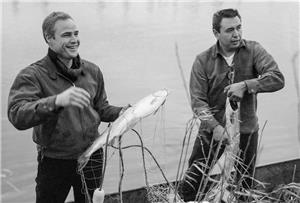On March 2, 1964, Native Americans protest the denial of treaty rights by fishing in defiance of state law. Inspired by sit-ins of the civil rights movement, Actor Marlon Brando (b. 1924), Episcopal clergyman John Yaryan from San Francisco, and Puyallup tribal leader Bob Satiacum (1929-1991) catch salmon in the Puyallup River without state permits. The action is called a fish-in and results in the arrest of Brando and the clergyman. Satiacum is not arrested. The Pierce County Prosecutor refuses to file charges and Brando and Yaryan are released.
Whenever tribal members fished for salmon and steelhead trout off their tiny reservations, they were held subject to state law. State regulations prohibited the use of nets and traps even though these were traditional Native methods of taking fish from rivers and streams. Native Americans insisting on their rights guaranteed by Treaties signed by Territorial Governor Isaac Stevens (1818-1862), were subjected to arrest and prosecution. The right to fish became a unifying identity among the diverse tribes of Puget Sound, which traditionally were tied to natural resources rather than to real estate.
The fish-in was staged by the National Indian Youth Council, a Native American civil rights organization formed in Gallup, New Mexico, in 1961. NIYC members participated in "freedom rides" and civil rights marches in Alabama and Mississippi, and applied their knowledge of activism and civil disobedience to tribal issues. Fish-ins were used throughout the 1960s to dramatize racial discrimination, pride in native heritage, and to assert treaty rights.
In 1974, a Federal court ruled that the tribes were entitled to half the salmon in Western Washington.

